If you love baking, you must have old cookie cutters rolling around in your kitchen drawers. But what if I told you those vintage metal pieces aren’t just biscuit molds but rare collectibles worth up to a hundred dollars or more?
Antique cookie cutters have recently become quite popular as kitchen collectibles. If you want to know whether yours are worth money, this guide will explain how to identify a valuable vintage cookie cutter, plus some rare examples to look for!
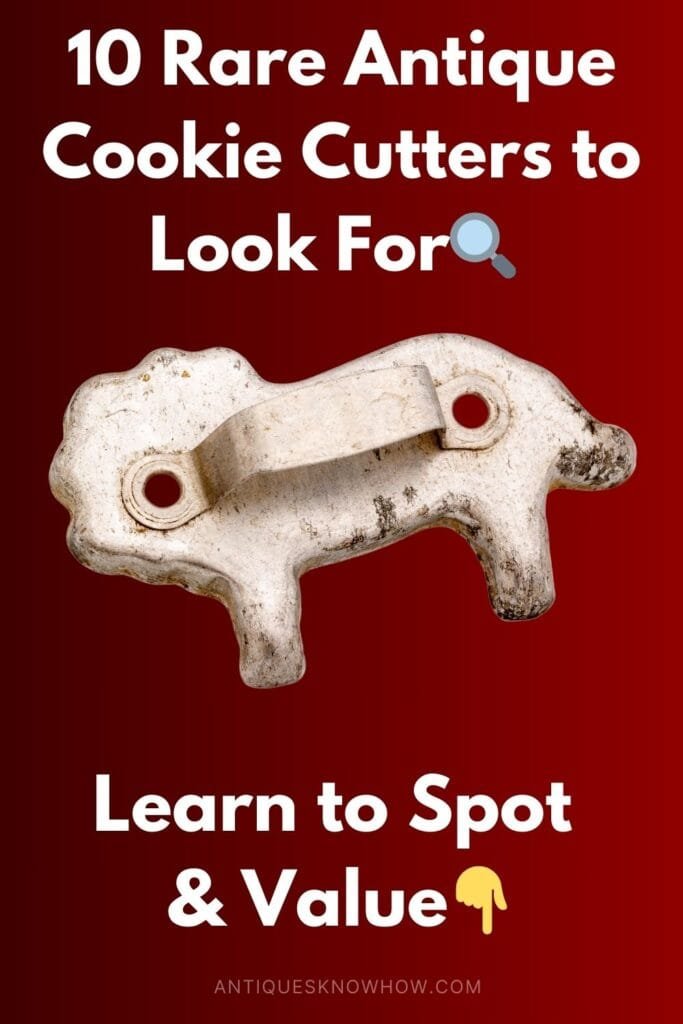
How to Spot Valuable Antique Cookie Cutters? (5 Key Factors)
Spotting rare and valuable old cookie cutters needs good understanding of their different designs (shapes), materials, and brands. If you are new at it, here’s a breakdown of the 5 key factors that indicate whether a vintage biscuit cutter will be worth money or not!
1. Material
Over the years, different materials have been used to make cookie cutters. These materials not only help identify the time period a cutter was made in, but also impact the value of the cookie cutter. Here are the most common materials to look for:
- Tin: Tin was the most common cookie-cutter material back in the 1800s and the early 1900s. Tin cutters were generally handmade (rarely soldered) and mostly had handles made of metal or sometimes, of wood. Today, antique tin cookie cutters in good condition are rather rare and valuable.
- Copper: Copper was used to make high-quality handmade cookie cutters. Due to the metal value, copper cookie cutters can be more valuable today.
- Aluminum: Starting from the 20th century, aluminum became a popular material for cookie cutters as it was light and easy to shape. Due to greater ability to mold, aluminum cutters had more complicated shapes, such as character shapes. But these are generally less valuable.
- Plastic: The use of plastic for cookie cutters began in the mid-20th century. Many plastic home product manufacturers, including Tupperware, began mass-producing cookie cutters. Plastic examples are the least valuable of all.
2. Cutter Shapes & Styles
The shape of an antique cookie cutter can also indicate whether it’s valuable or not. How? Well, the rarer and more complex the shape, the more valuable the cookie cutter is.
Common Traditional Shapes:
These are the simplest cookie-cutter shapes, generally those without a lot of turns and bends. Examples include: shapes (circles, squares, etc), stars, hearts, moons, simple flowers, animals, and more. Basically, shapes are based on common things.
Holiday Theme Shapes:
These cookie cutters became popular in the 19th century. Many unique and complex shapes were produced, such as Christmas-theme shapes, including Santa, reindeer, and bells, and Easter bunnies, Halloween-themed shapes like pumpkins and witches.

Antique holiday-themed cookie cutters, especially Christmas-themed examples, are highly collectible today.
Novelty and Character Shapes:
After the rise of plastic cookie cutters, character-shaped cookie cutters became highly popular. These shapes are generally based on popular cartoon characters (such as Mickey Mouse), superheroes, children’s book characters (for example, Raggedy Ann), or pop culture figures.
Regional Art Shapes
Regional-style cookie cutters can also be particularly desirable today. These generally have unique, handmade primitive designs inspired by Folk art, such as cockerels, tulips, and hearts, etc.
3. Condition
The condition of an old cookie-cutter decides how valuable it’ll be. For example, if a cutter has holes, rust, or breaks, it will automatically be worth less than one without these flaws.
Since tin rusts, antique cookie cutters made of tin are very rare to find in good, rust-free condition today, making them highly valuable. Moreover, if a tin cookie cutter is in good condition and has a complex shape, it’ll be worth even more.
Another thing to note is that authentic antique cookie cutters, particularly those with handles, will have strong solder lines. Such examples were valued more than those with weak, no, or repaired soldering.
However, remember that some original patina (not rust) is common and a sign of natural aging in the case of tin cutters.
4. Brand Prestige and Markings
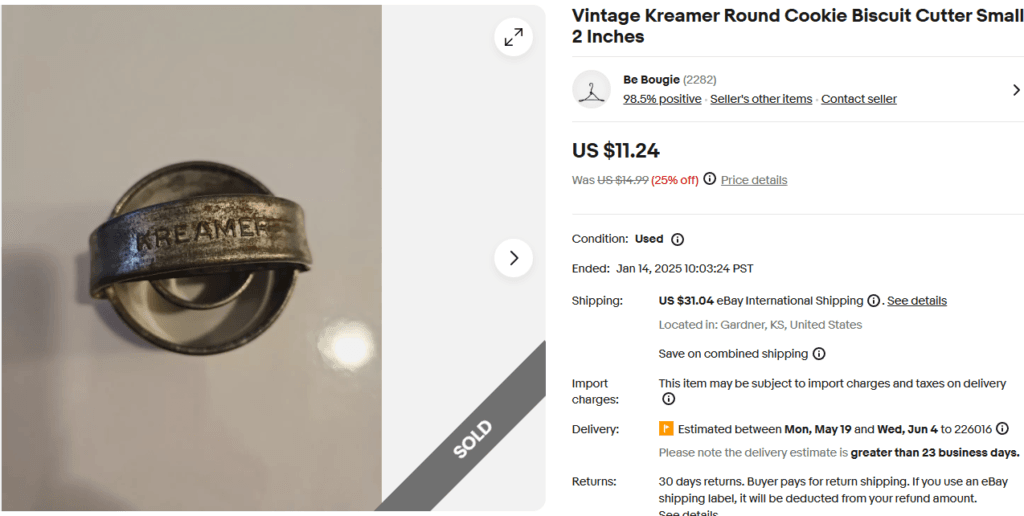
Over the years, many manufacturers made cookie cutters, but only some of them marked their pieces. Generally, cookie cutters that display the name of their makers are considered more valuable than those without any branding.
These marks (inscribed, engraved, or stamped) are generally found on the back plate or handle of the cutter.
Here are some prominent manufacturers whose cookie cutters typically fetch higher returns in the market:
- Dover (tin cutters)
- Mason’s (tin cutters with “Mason’s” marking engraved on the back)
- Kreamer (soldered tin cutters with “Kreamer” marking engraved on the handle)
- Fries (metal cookie cutters with “FRIES” marking engraved on the handle)
- K. Claggett (metal cutters with “K. Claggett” marking on the back)
- B. Cukla (metal cutters with “B. Cukla” marking on the back)
- Mirro (aluminum cutters with no branding)
- Wear-Ever (aluminum cutters with marking on the back)
5. Rarity
A vintage cookie cutter will be more desirable and valuable if it’s rare. Now, in the case of biscuit cutters, rarity mostly refers to the shapes or designs. For instance, circles, stars, hearts, etc, are pretty common shapes.
On the other hand, complex and unique shapes, such as a single hand, heart in hand, trees, stags, stylized people, boots, or shoes, are rarer and particularly sought after. Oddly shaped cutters also fetch higher values.
In addition, promotional cookie cutters made for certain companies or merchandise are also considered rare, like this Dover Rumford Cookie cutter set of 3.
Most Valuable Vintage Cookie Cutters Worth Money
Now, let’s check out the rarest vintage cookie cutters that can sell for a few hundred dollars today!
1. Uncle Sam Cookie Cutter

This is easily one of the most expensive antique cookie cutters ever sold. It’s a late 19th-century tin cutter made by G. M. T. Company shaped as Uncle Sam, which is the personification of the United States. This example sold for $1,250 on eBay, which is an exceptional price for a cookie-cutter.
2. Heart & Hand Tin Cookie Cutter

The “heart and hand” is one of the most sought-after cookie-cutter designs. This example, although unbranded, sold for over $350 due to the rarity of the shape and its rust-free condition.
3. Letang Fils Gentleman Cookie Mold Pair

This is a unique antique metal cookie mold of a gentleman with a cane and a top hat. Made by French maker, Letand Fils, this one comes as a pair of the left and right profile of the men with highly detailed molds, such as buttons in the coat, waves in the hat, eyes, etc.
4. Hand & Heart Folk Art Cookie Cutter
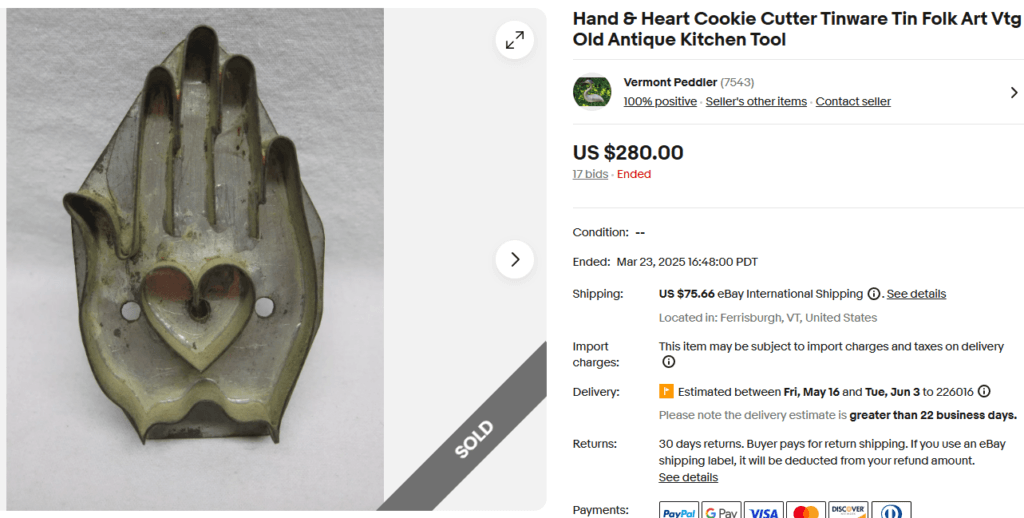
This is another version of the hand and heart cutter shape, in which the heart is inside the palm. Antique tin cutters with this shape are also quite desirable, with those in good condition fetching up to $200-$300.
5. Antique Angel Cookie Mold

Christmas-themed cookie cutters are one of the most popular examples. This one is a large, 13+ inches Christmas-themed soldered tin mold of an angel. Such examples can fetch $100-$250, especially in good condition without much rust or breaks.
6. Cape Cod Copper Elf Cookie Cutter

This is a rare copper cookie cutter shaped as an elf made by the Cape Cod Copper Works, as marked on the cutter rim. Due to its copper make as well as its unique shape, this biscuit cutter sold for almost $150 on eBay.
7. K. Claggett Tin Hand and Dove Cookie Mold
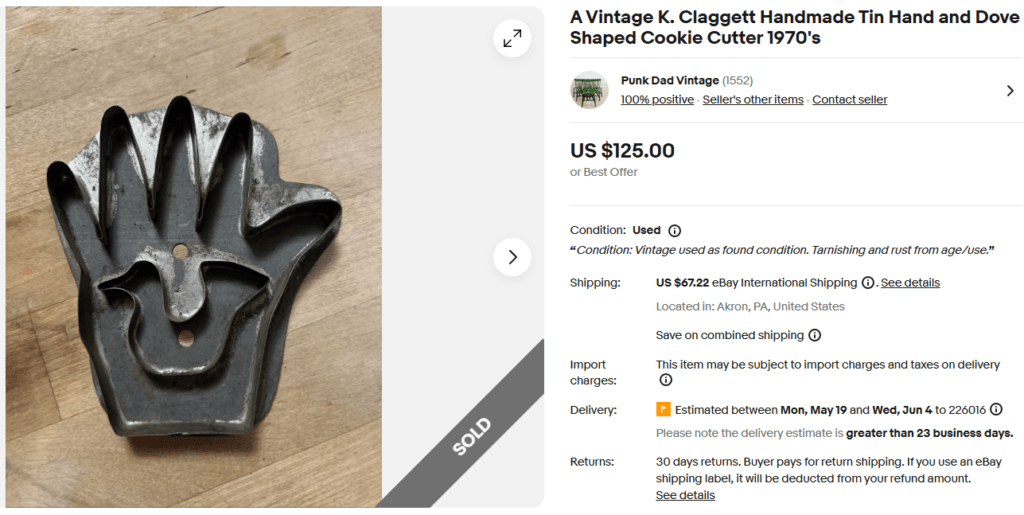
The “hand and dove” is another rare shape inspired by Folk Art designs. This handmade tin example was made by K. Claggett in the 1970s, as marked on the back. In good condition, this cookie mold shape can fetch $80-$150.
8. Old River Road Copper Easter Carrot Cookie Cutter
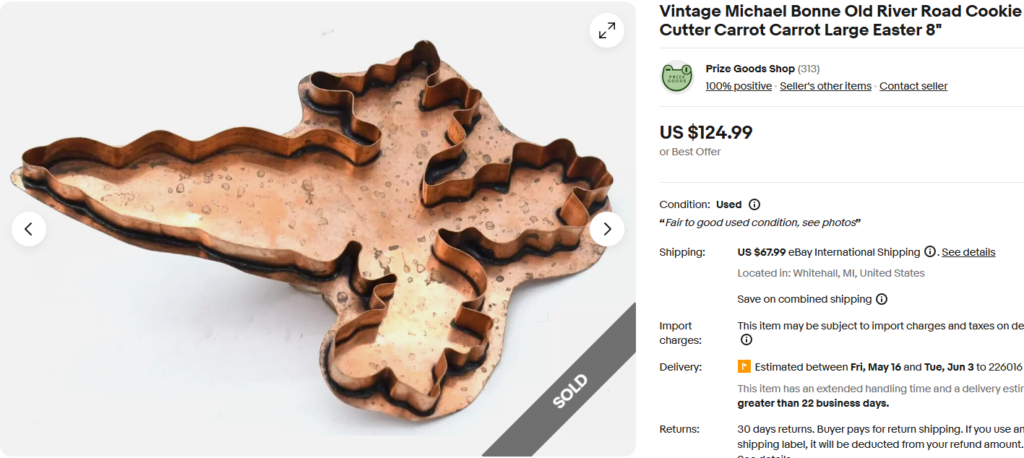
This is an Easter-theme large carrot-shaped cookie mold from Old River Side, marked at the back. Designed by Michael Bonne, the cutter features sharp bends and curves, replicating a real carrot with foliage. Its unique design and copper composition make it a collectible piece.
9. B. Cukla Witch on a Broom Cookie Cutter
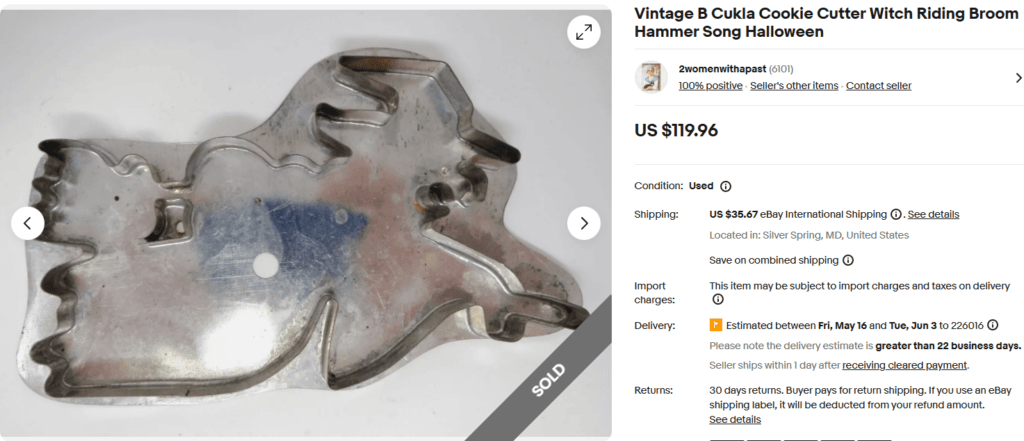
This rare Halloween-themed cookie cutter from B. Cukla is a metal mold of a witch riding a broom. Being a holiday-themed cutter from a renowned manufacturer, this is a collectible example, often fetching around $40-$100 if found without much wear and tear and rust.
10. Mirro Halloween-theme Cookie Cutter Set

This is a rare Halloween-themed Cooky-Cat and Man-In-the-Moon cookie-cutter set from Mirro. Although it’s aluminum, it’s collectible because of the Halloween theme. The set features a witch on the broom, two cats, and a crescent moon cutter. Today, it sell for about $20-$40, depending on condition and packaging.
Note: This article is intended for informational, educational, and entertainment purposes only. Some images are illustrative and may not represent actual brands, products, or related entities. All trademarks, product names, brand logos, packaging, and other intellectual property referenced remain the exclusive property of their respective owners. Any brand mentions or references are provided solely for descriptive and educational context and do not imply any formal or commercial association.

